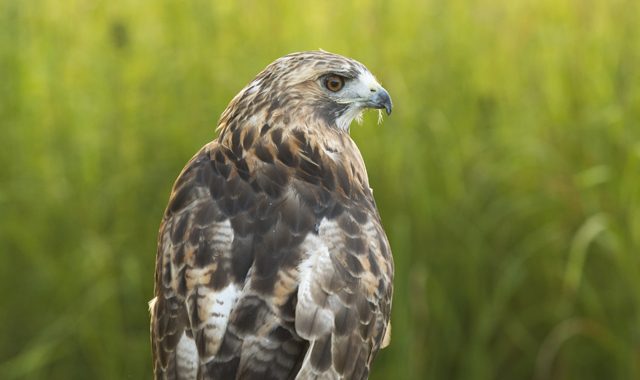Only a few decades ago, hawks were nearly wiped out, when humans thoughtlessly poisoned them. Today, these magnificent creatures remind us that adapting to new realities is imperative for survival.

It can be a brief and sudden moment – a swift rustling of wings, a flash of rufous feathers – and it’s gone. Hawk sightings in the prairies and woodlands of our region reveal a fleeting image of the fierce, wild beauty in native creatures all around us. Opportunities to see hawks are becoming more common, even in our own backyards. These magnificent birds of prey are quickly adapting to the changing landscape, making homes in suburban and even urban environments.
“I think when people see a hawk, or at least when I do, it does create a sense of adventure,” says David C. Olson, a photographer based in Rockford. “It’s amazing to see such a beautiful bird flying on the wing like that, soaring high above.”
Over the past year, Olson has spent countless hours looking for these birds within Winnebago and Boone County, Ill., observing their behaviors and waiting for perfect opportunities to capture their natural form with his camera. Some species are highly visible above open stretches of land or atop looming vantage points. Others require careful searching within dense forests and rugged marshes.
“Birds in general are really tough to photograph because they can fly away from us so easily,” Olson says. “You have to get the shot quickly, because once they leave, you may not find them again. Some days I might go out and not get that much, and then some days my luck can change within minutes of seeing something incredible – maybe I’ll see one during a kill or when it’s feeding its young. Your whole luck can change in a minute.”
Even when a hawk makes a fleeting appearance, it can be difficult to identify the species accurately. By knowing which ones live close by and their preferred habitats, diets and behaviors, observers can more easily spot these raptors within their own neighborhoods.
“I kind of call myself a naturalist in the aspect that I do a lot of observation while I’m photographing,” says Olson. “Some of these species I may spend days or weeks photographing. And just by watching, I’m able to learn so much beyond reading about them from books.”
Many species can stay in our region year-round, while some migrate through during certain seasons. With the help and knowledge from some of Northern Illinois’ raptor center experts, these species can be better understood, identified and appreciated in their natural habitats throughout the region.
Soaring On High
Hawks can be broken into two raptor identification categories: buteos and accipiters. The first is considered the most “typical,” when one thinks of hawks. Buteos are also the most common, both in numbers and sightings. With broad, rounded wings and short, fan-shaped tails, these birds are built for prolonged flights high above open areas and like to perch atop telephone lines and light poles as they search for prey. Even from afar, their large bodies make them easy to spot.
Like many birds of prey, hawk populations greatly suffered when people used DDT and other powerful insecticides, before many of these chemicals were banned in the 1970s. Hawks have since regained their numbers and come back from near-extinction, in part because they quickly adapt to changing landscapes.
“One of my favorites around the area, and I think a favorite for a lot of people, is the red-tailed hawks,” says Olson. “They’re just one of the more beautiful hawks that we have in our area, and they’re the most plentiful. They’re also the largest of the buteo hawks.”
Candy Ridlbauer, executive director of the Northern Illinois Raptor Rehab and Education organization located in Loves Park, has been working with raptors for 18 years. Since forming in 2004 and becoming a 501(c)3 nonprofit in 2008, her organization serves to rescue, rehabilitate and release birds of prey and educated local residents about the value of these creatures. She says red-tailed hawks are often brought to the center.
“Red-tails are now choosing to live so close to where we live because they are such adaptive birds,” says Ridlbauer. “So a lot of people see them almost on a daily basis, because their numbers are greater now than they’ve ever been.”
The key to understanding this species’ success is knowing their flexible habitat and dietary needs, says Nabeel Rasheed, bird handler at the Northern Illinois Raptor Center in Hoffman Estates. The nonprofit educates local residents about the importance of birds of prey and nurses injured raptors that are unable to live in the wild.
“Red-tails like to hunt on open ground, so highways are just perfect places for them, with all those strips of native grass,” says Rasheed. “Even in the city, we have lots of stands of trees and open ground, so it’s almost like their native environment. These birds are typically monogamous, if they successfully raise a brood in a location, so they tend to stay together and come back to the same place.”
Red-tailed hawks dwell in all geographic areas of North America, with variations spreading from subarctic climates down to the Caribbean, says Rasheed. Their diets vary dramatically, and include eating anything from bugs to rabbits. This makes it hard to identify red-tailed hawks across different regions, as they appear in a wide variety of colored morphs. Some aren’t red at all. There’s even an “albino” red-tailed hawk, formally called the leucistic red-tail. Northern Illinois mainly hosts red and brown variations.
Two other common buteos here are the red-shouldered hawk and the broad-winged hawk; both appear in lower numbers.
“Red-shouldered hawks are the counterpart to the barred owl,” says Ridlbauer. “Wherever you find a barred owl, there’s a good chance you can find a red-shouldered hawk because they both live in woodland and marshy habitats and go after similar prey, such as snakes, toads, frogs and mammals.”
Broad-winged hawks prefer densely wooded areas, which makes them more difficult to spot. Both species are rarely brought into the rehab organization, Rildbauer says, due to their reclusive habitats. Broad-winged hawks are known for their annual migration to South American climates; they travel in flocks, called “kettles,” sometimes up to thousands of birds. The fall and spring migratory seasons are the most common times to catch a sighting, says Ridlbauer.
Navigating Forests Expertly
Much smaller in size, accipiters are the faster-flying, more energetic hawk types. They navigate at incredible speeds through dense and twisted habitats to catch their prey, often smaller bird species, in mid-flight. Their relatively long tails and short, sharp-tipped wings help them to steer through the air with agile precision.
The Cooper’s hawk is the most common accipiter in Northern Illinois and is also the second largest of it classification. Local raptor centers have experienced an increase in the number of Cooper’s hawks brought in for rehabilitation.
“We hardly got any in when I first started 18 years ago, and when we did, they would die so easily because they just couldn’t stand the stress,” says Ridlbauer. “Now, we’re getting them in all the time, and much like the two we got this summer, they’re high strung with energy. People are seeing them more and more now that their numbers have gone up and the birding industry has grown.”
Given their diet of mostly songbirds, Cooper’s hawks have a sullied reputation among bird lovers.
“The typical story about a Cooper’s hawk is that, when somebody gets a bird feeder, all of a sudden they’ll find bits of feathers or notice that all the birds have gone silent,” says Rasheed. “So I always say it’s most likely a Cooper’s hawk that’s taken up residence nearby and has found a bird feeder.”
Cooper’s hawks also feed on small mammals, such as chipmunks, mice and other rodents. Much like red-tailed hawks, they’ve adapted to changing conditions and crept into suburban areas.
Their quick flying speeds and preference for densely wooded areas make accipiters particularly hard to find and hard to identify, during the few moments they’re seen. A closer look at their physical attributes reveals information. Cooper’s hawks’ eyes slowly change color as they grow older, from grayish-yellow to orange and then to red during adulthood. Vertical streaks of dark color across the chest change into horizontal bars as they age, and backside feathers become more gray.
Another common accipiter in the region is the sharp-shinned hawk. The smallest hawk in North America, they’re notoriously hard to distinguish from Cooper’s hawks. Even though buteos and accipiters are generally distinguished by their sizes, this isn’t foolproof.
“For most raptors, the females are much larger than the males themselves,” says Rasheed. “So a male Cooper’s hawk would almost be the same size as a female sharp-shinned hawk, so that can be another confusing element for classifications.”
Learning to Live Together
With the population of these hawks on the rise, raptor centers are providing resources to help people understand the value of these birds and to discourage humans from harming them. Two injured Cooper’s hawks were brought into the Northern Illinois Raptor Rehab and Education center this summer, one after being injured by a BB gun in Boone County.
“The bird is possibly releasable, but the BBs will stay in place for the rest of its life,” says Ridlbauer. “These birds are protected by the Migratory Bird Treaty Act. It is illegal to shoot them, to poison them, to do anything with their nests. It’s actually illegal even to possess their feathers.”
After coming so close to extinction, the hawk’s ability to regain numbers and adapt to a changing environment is a magnificent thing to witness. Their removal from the Endangered Species list should be seen as a success story to be protected, says Rasheed.
“When I first started in the field, the woman that I was working with said red-tailed parents will keep the kids around for maybe two or three weeks, then they kick them out of the territory once they start flying,” says Ridlbauer. “But now we’re seeing them stay together even into late September. So that’s a really positive change.”
Staff members at local raptor centers continually work to better understand hawks and to share their knowledge of them with the general public. They make regular visits to schools, area events and other organizations to give presentations on these native raptors and increase the appreciation and awareness for them. People can see these birds upclose during visiting hours. For more information, check out northernillinoisraptor.org and tnirc.org.
“Our kids know more about exotic animals and dinosaurs than they know about these creatures that live right among us,” says Rasheed. “With these hawks, you’re seeing a piece of wilderness that’s not exotic, but right here. I can go home and I won’t be surprised if I see a Cooper’s hawk sitting outside my door.”
But this hasn’t always been the case, and Rasheed doesn’t take it for granted, given the peril hawks faced in recent history.
“There’s something about birds, right? Who hasn’t thought how cool it would be to fly like a bird? There’s some kind of visceral connection that humans have with birds. But we also never get to see them up close, especially raptors like these, birds of prey who have to hunt and kill what they eat. It’s an honor to work with them.”
David C. Olson maintains a studio and gallery just off I-90 in Rockford, at the Clock Tower Inn, 7801 E. State St. See more of his work at DavidOlsonPhotography.com.




















































